Observations of Local Meteorological Variability under Large-Scale Circulation Patterns over Athens, Greece
Abstract
:1. Introduction
2. Methods
2.1. Experimental Site
2.2. Geometric Structures
2.3. Mesoscale Flows
2.4. Classification of the Synoptic Scale Circulation
3. Results
3.1. General Features
3.1.1. Synoptic Scale Circulation
3.1.2. Surface Variability
3.1.3. Mesoscale Circulation
3.1.4. Geometric Structures
3.2. Links between large-Scale Circulation, Mesoscale Surface Patterns and Geometric Structures
3.2.1. Large-Scale Circulation and Mesoscale Surface Variability
3.2.2. Large-Scale Circulation and Mesoscale Surface Flows: Integral Quantities
3.2.3. Large-Scale Circulation and Geometric Structures
3.2.4. Mesoscale Surface Patterns and Geometric Structures
4. Discussion and Concluding Remarks
Acknowledgments
Author Contributions
Conflicts of Interest
References
- World Meteorological Organization. Seamless Prediction of the Earth System: From Minutes to Months; Brunet, G., Jones, S., Ruti, P.M., Eds.; World Meteorological Organization: Geneva, Switzerland, 2015. [Google Scholar]
- Barlow, J.; Best, M.; Bohnenstengel, S.I.; Clark, P.; Grimmond, S.; Lean, H.; Christen, A.; Emeis, S.; Haeffelin, M.; Harman, I.N.; et al. Developing a Research Strategy to Better Understand, Observe, and Simulate Urban Atmospheric Processes at Kilometer to Subkilometer Scales. Bull. Am. Meteorol. Soc. 2017, 98, ES261–ES264. [Google Scholar] [CrossRef]
- Mihalakakou, G.; Flocas, H.A.; Santamouris, M.; Helmis, C.G. The impact of synoptic scale atmospheric circulation on the urban heat island over Athens, Greece. J. Appl. Meteorol. 2002, 41, 519–527. [Google Scholar] [CrossRef]
- Kassomenos, P.; Flocas, H.A.; Skouloudis, A.N.; Lykoudis, S.; Asimakopoulos, V.D.; Petrakis, M. Relationship of air quality indicators and synoptic scale circulation at 850 hPa over Athens during 1983–1995. Environ. Technol. 1999, 19, 13–24. [Google Scholar]
- Flocas, H.A.; Kelesis, A.; Helmis, C.G.; Petrakakis, M.; Zoumakis, N. Synoptic and local scale atmospheric circulation associated with air pollution episodes in an urban Mediterranean region. Theor. Appl. Climatol. 2009, 95, 265–277. [Google Scholar] [CrossRef]
- Taylor, M.; Retalis, A.; Flocas, H. Particulate matter estimation with photochemistry: A modeling approach using neural networks and synoptic clustering. Aerosol Air Qual. Res. 2016, 16, 2067–2084. [Google Scholar] [CrossRef]
- Kassomenos, P.; Flocas, H.A.; Lykoudis, S.; Petrakis, M. Analysis of mesoscale patterns in relation to synoptic conditions over an urban Mediterranean basin. Theor. Appl. Climatol. 1998, 59, 215–229. [Google Scholar] [CrossRef]
- Halios, C.H.; Helmis, C.G.; Flocas, H.A.; Nyeki, S.; Assimakopoulos, D.N. On the variability of the surface environment response to synoptic forcing over complex terrain: A multivariate data analysis approach. Meteorol. Atmos. Phys. 2012, 118, 107–115. [Google Scholar] [CrossRef]
- Sioutas, M.; Flocas, H.A. Hailstorms in Northern Greece: Synoptic patterns and thermodynamic environment. Theor. Appl. Climatol. 2003, 75, 189–202. [Google Scholar] [CrossRef]
- Yarnal, B. Synoptic Climatology in Environmental Analysis: A Primer; Belhaven Press: London, UK, 1993. [Google Scholar]
- Maheras, P.; Patrikas, I.; Karacostas, T.; Anagnostopoulou, C. Automatic classification of circulation types in Greece: Methodology, description, frequency, variability and trend analysis. Theor. Appl. Climatol. 2000, 67, 205–223. [Google Scholar] [CrossRef]
- Maheras, P.; Flocas, H.; Tolika, K.; Anagnostopoulou, C.; Vafiadis, M. Circulation types and extreme temperature changes in Greece. Clim. Res. 2006, 30, 161–174. [Google Scholar] [CrossRef]
- Helmis, C.G.; Asimakopoulos, D.N.; Papadopoulos, K.H.; Kalogiros, J.A.; Kassomenos, P.; Papageorgas, P.G.; Blikas, S. Air mass exchange between the Athens Basin and the Messogia Plain of Attika, Greece. Atmos. Environ. 1997, 31, 3833–3849. [Google Scholar] [CrossRef]
- Gao, W.; Shaw, R.H.; Paw, U.R.T. Observation of organized structure in turbulent flow within and above a forest canopy. Bound. Layer Meteorol. 1989, 47, 349–377. [Google Scholar] [CrossRef]
- Taylor, R.J. Thermal Structures in the Lowest Layers of the Atmosphere. Aust. J. Phys. 1958, 11, 168–176. [Google Scholar] [CrossRef]
- Barthlott, C.; Drobinski, P.; Fesquet, C.; Dubos, T.; Pietras, C. Long-term study of coherent structures in the atmospheric surface layer. Bound. Layer Meteorol. 2007, 125, 1–24. [Google Scholar] [CrossRef]
- Serafimovich, A.; Thomas, C.; Foken, T. Vertical and Horizontal Transport of Energy and Matter by Coherent Motions in a Tall Spruce Canopy. Bound. Layer Meteorol. 2011, 140, 429–451. [Google Scholar] [CrossRef]
- Boppe, R.S.; Neu, W.L.; Shuai, H. Large-Scale Motions in the Marine Atmospheric Surface Layer. Bound. Layer Meteorol. 1999, 92, 165–183. [Google Scholar] [CrossRef]
- Gallego-Castillo, C.; Cuerva-Tejero, A.; Lopez-Garcia, O. A review on the recent history of wind power ramp forecasting. Renew. Sustain. Energy Rev. 2015, 52, 1148–1157. [Google Scholar] [CrossRef]
- Belušić, D.; Mahrt, L. Is geometry more universal than physics in atmospheric boundary layer flow? J. Geophys. Res. 2012, 117, D09115. [Google Scholar] [CrossRef]
- Halios, C.H.; Helmis, C.G.; Asimakopoulos, D.N. Studying geometric structures in meso-scale flows. Front. Environ. Sci. 2014, 2, 47. [Google Scholar] [CrossRef]
- Georgakis, C.; Santamouris, M.; Kaisarlis, G. The Vertical Stratification of Air Temperature in the Center of Athens. J. Appl. Meteorol. Climatol. 2010, 49, 1219–1232. [Google Scholar] [CrossRef]
- Allwine, K.J.; Whiteman, C.D. Single-station integral measures of atmospheric stagnation, recirculation and ventilation. Atmos. Environ. 1994, 28, 713–721. [Google Scholar] [CrossRef]
- Wilks, D.S. Statistical Methods in the Atmospheric Sciences, 2nd ed.; Academic Press: Cambridge, MA, USA, 2006. [Google Scholar]
- Levy, I.; Dayan, U.; Mahrer, Y. A five-year study of coastal recirculation and its effect on air pollutants over the East Mediterranean region. J. Geophys. Res. 2008, 113, D16121. [Google Scholar] [CrossRef]
- Zagouras, A.; Argiriou, A.; Flocas, H.A.; Economou, G.; Fotopoulos, S. An advanced Method for Classifying Atmospheric Circulation Types based on Prototypes Connectivity Graph. Atmos. Res. 2012, 118, 180–192. [Google Scholar] [CrossRef]
- Kassomenos, P.; Gryparis, A.; Samoli, E.; Katsouyianni, K.; Lycoudis, S.; Flocas, H.A. Atmospheric circulation types and daily mortality in Athens, Greece. Environ. Health Perspect. 2001, 109, 591–596. [Google Scholar] [CrossRef] [PubMed]
- Mahrt, L. Common microfronts and other solitary events in the nocturnal boundary layer. Q. J. R. Meteorol. Soc. 2010, 136, 1712–1722. [Google Scholar] [CrossRef]
- Koch, S.E.; Feltz, W.; Fabry, F.; Mariusz, P.; Geerts, B.; Bedka, K.M.; Miller, D.O.; Wilson, J.W. Turbulent mixing processes in bores and solitary waves deduced from profiling systems and numerical simulation. Mon. Weather Rev. 2008, 136, 1373–1400. [Google Scholar] [CrossRef]
- Kostopoulou, E.; Jones, P. Comprehensive analysis of the climate variability in the eastern Mediterranean. Part II: Relationships between atmospheric circulation patterns and surface climatic elements. Int. J. Climatol. 2007, 27, 1351–1371. [Google Scholar] [CrossRef]
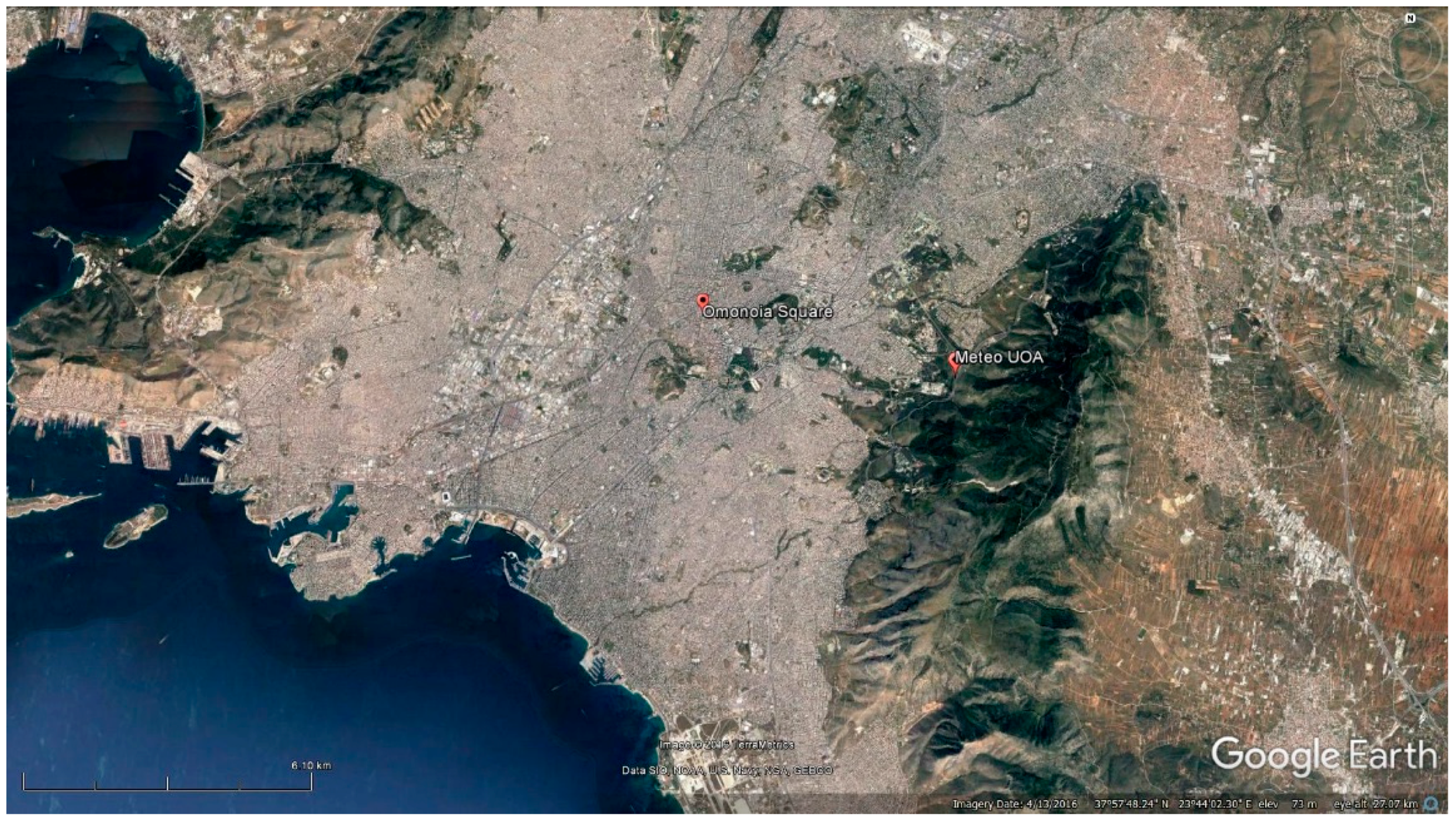
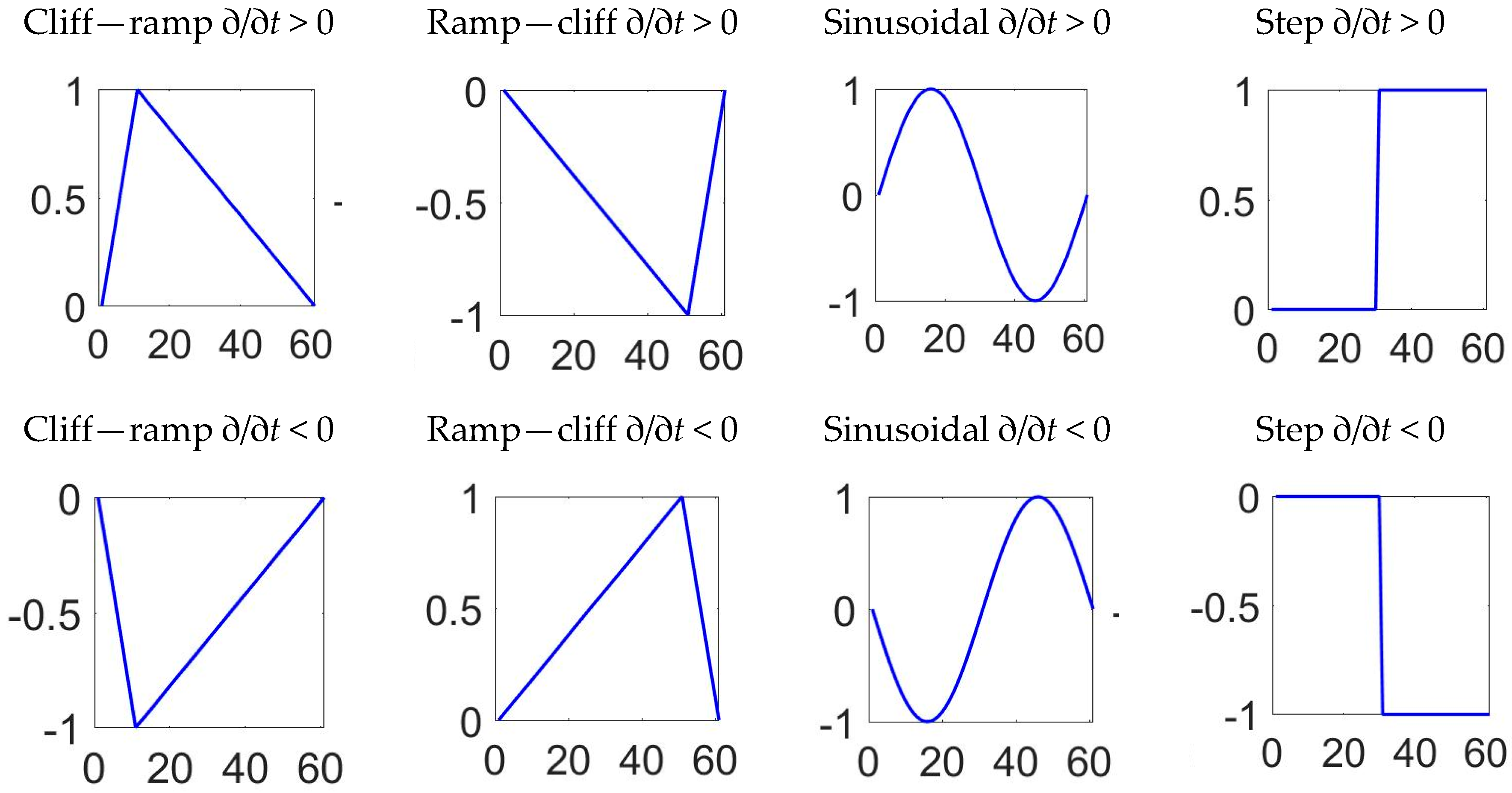
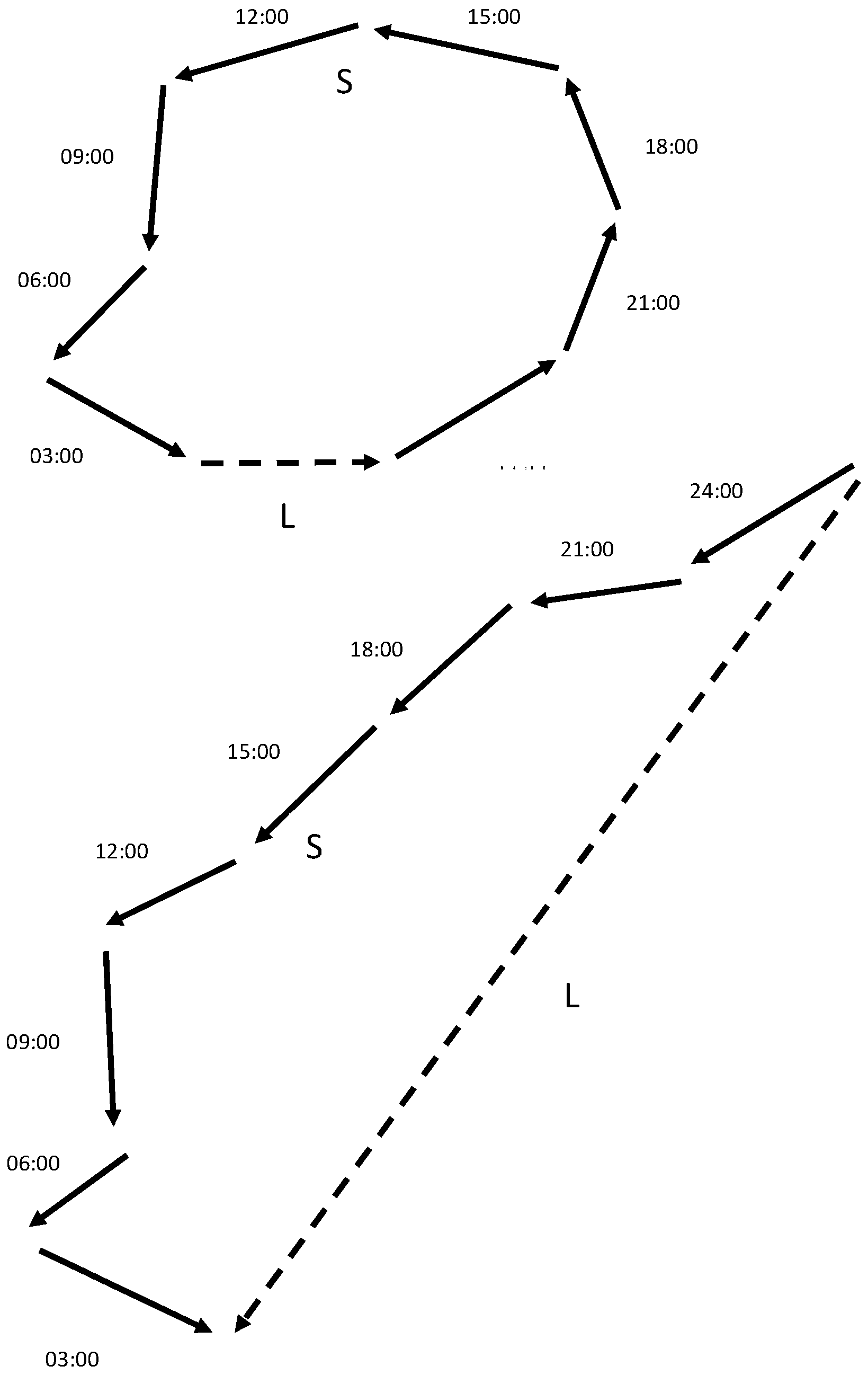


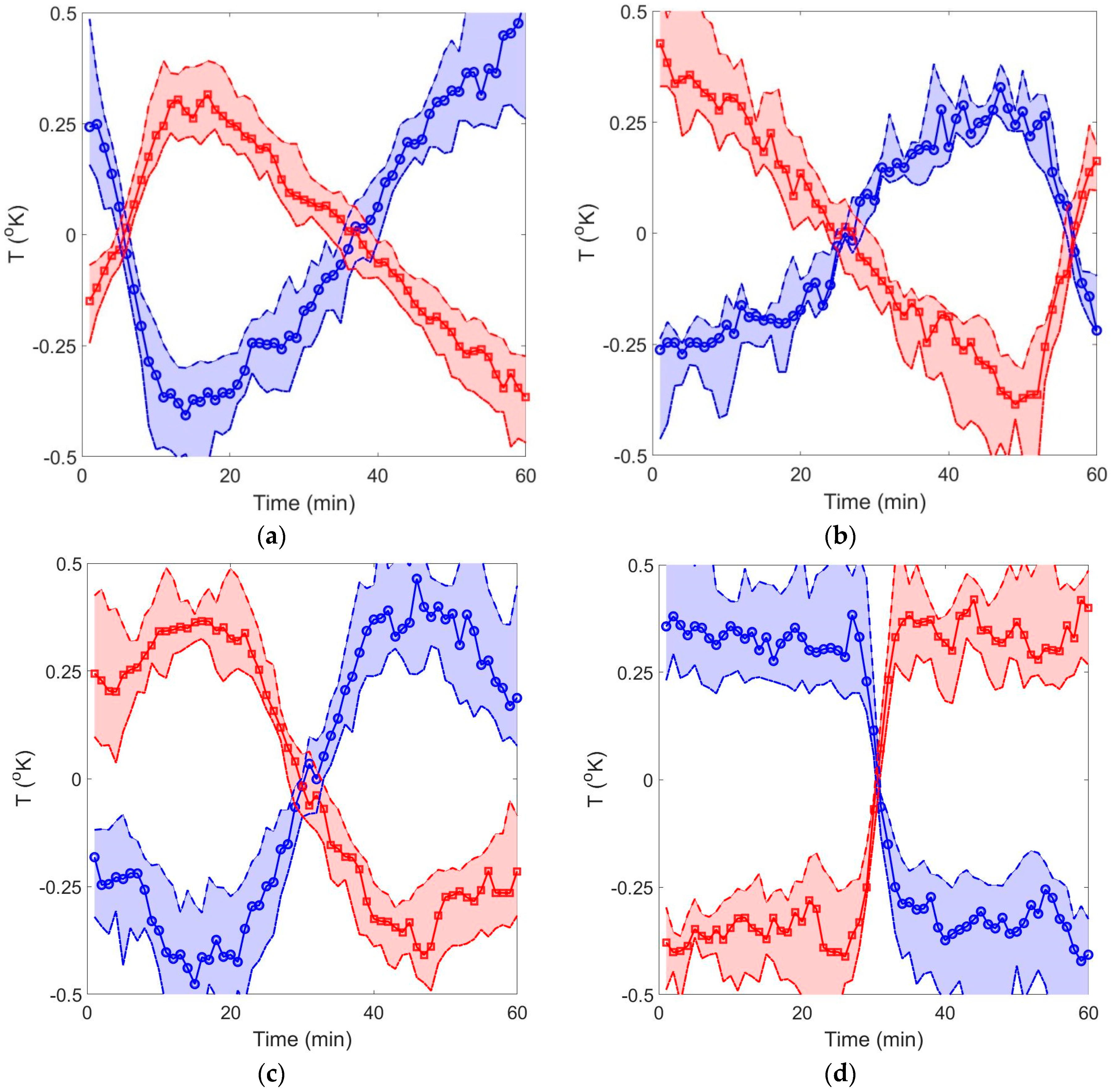
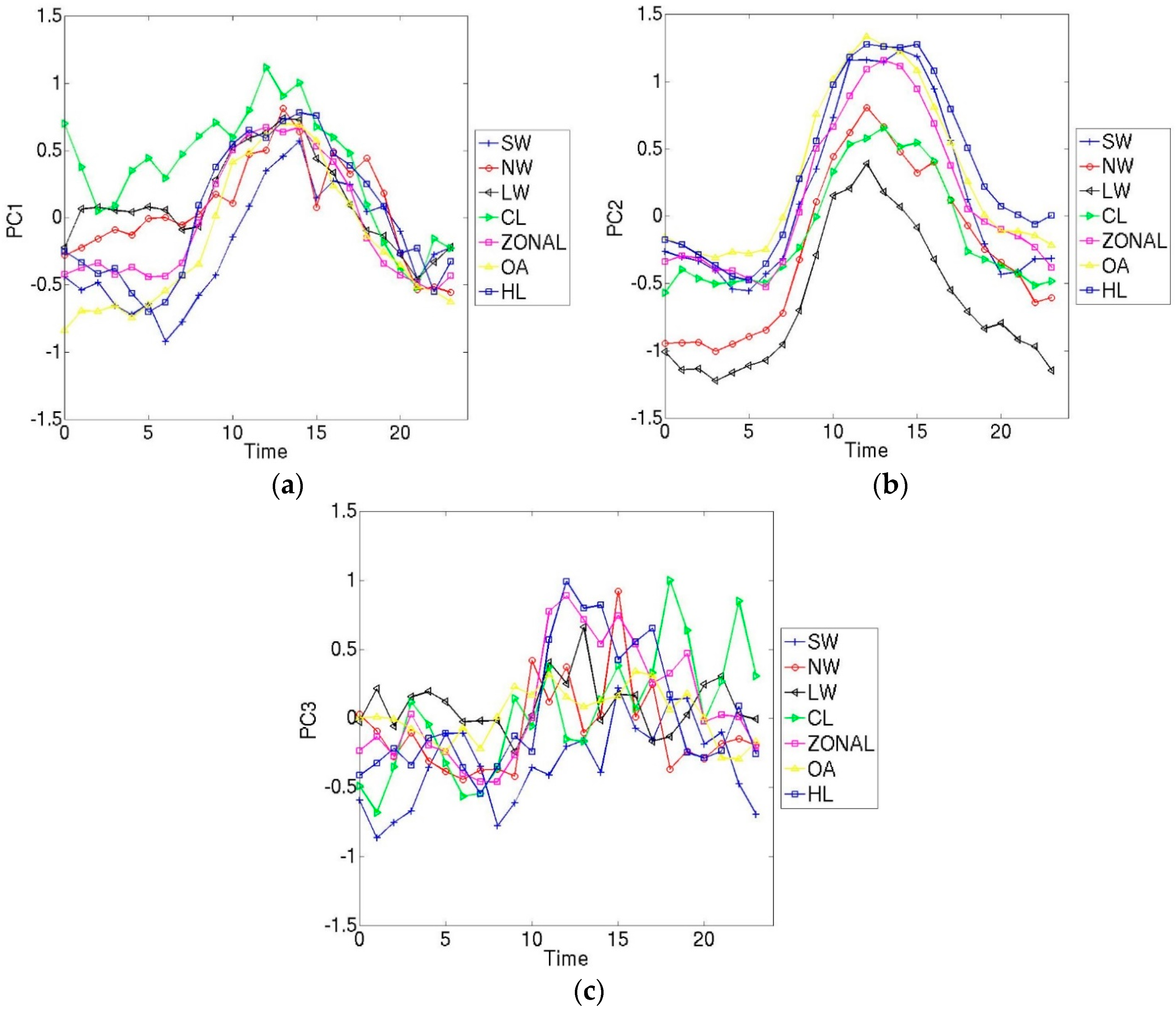


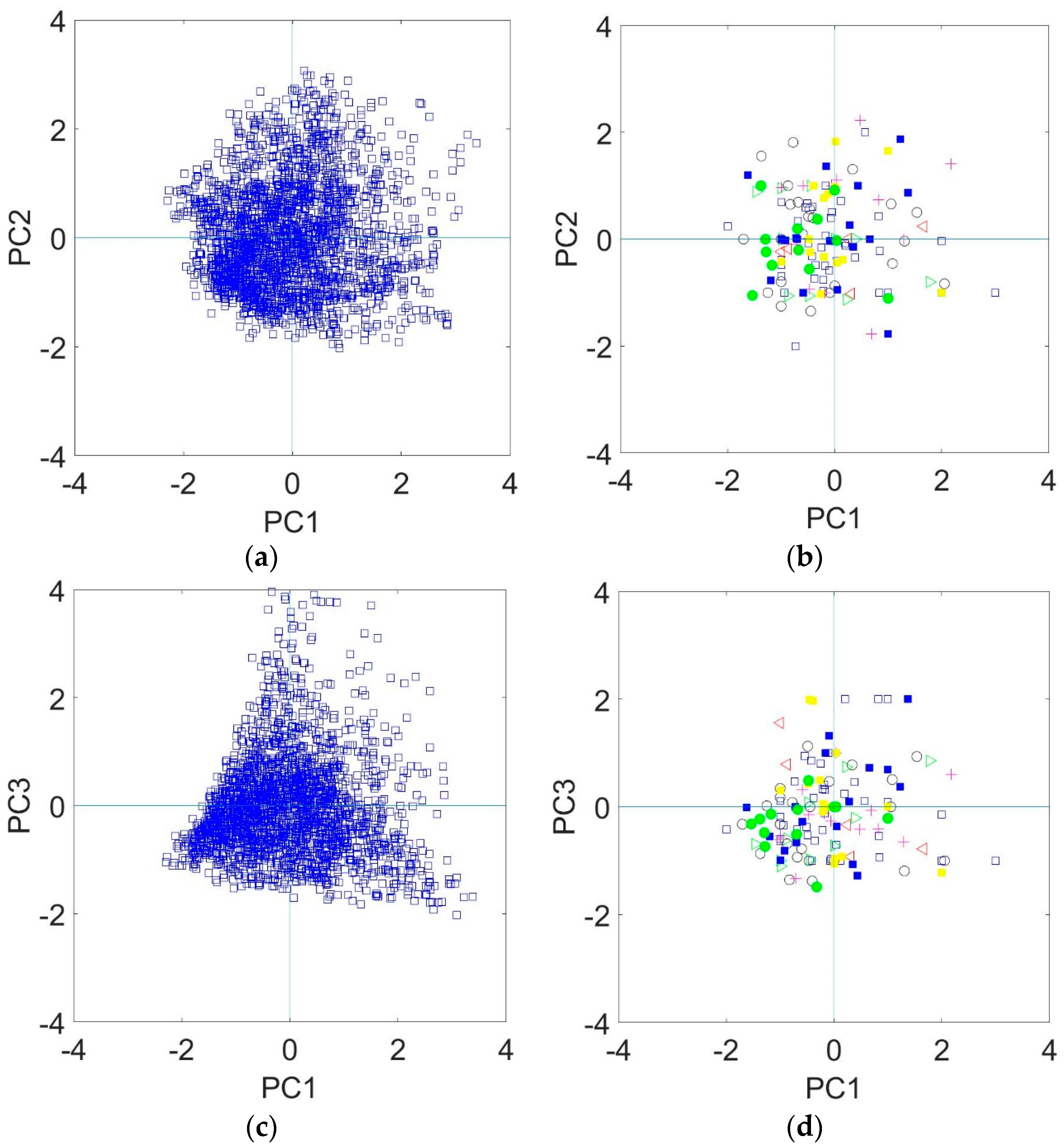
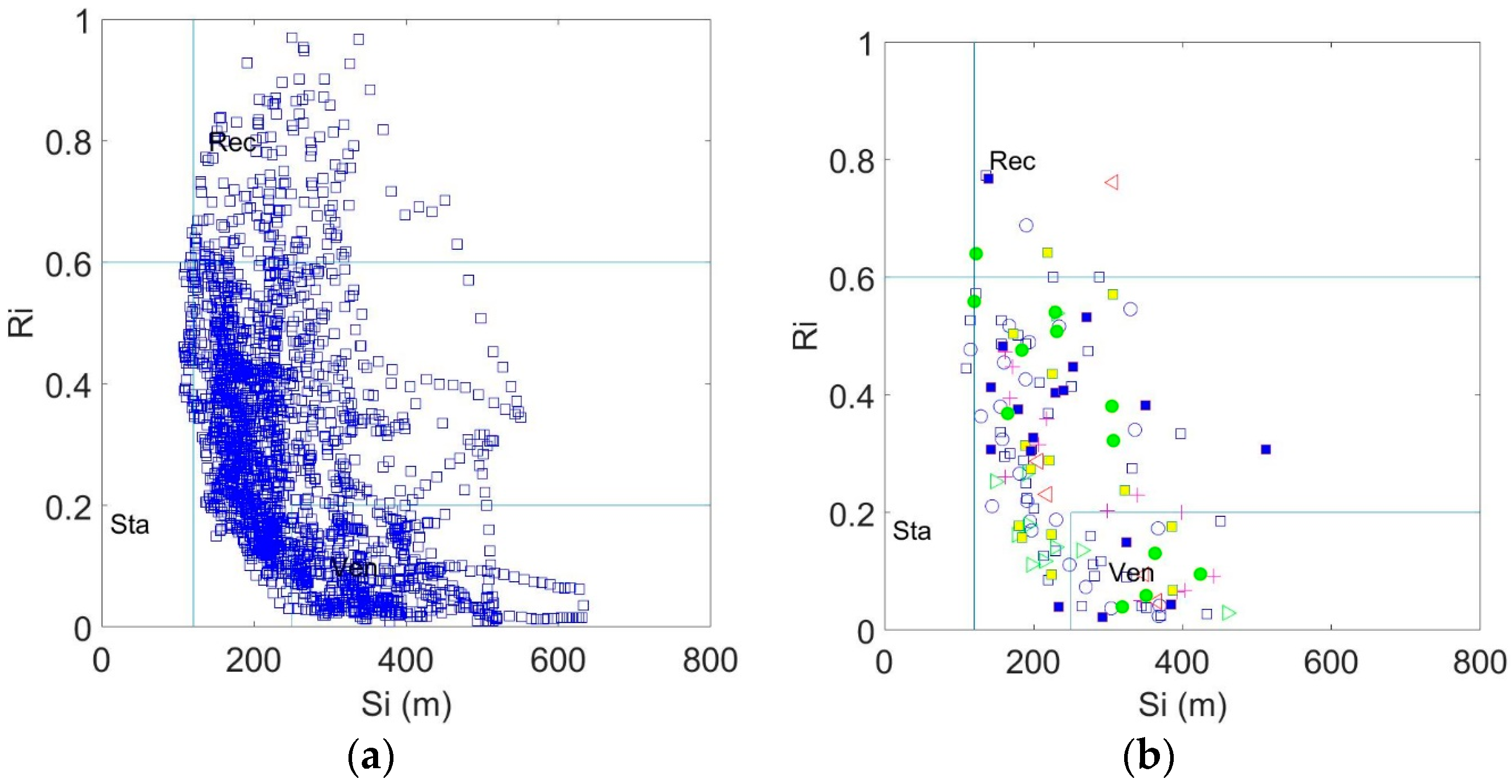
| Categories | 2000(Relative Frequency) | 1983–2015(Relative Frequency) | z Value |
|---|---|---|---|
| SW | 13.9 | 10.9 | 0.57 |
| NW | 13.0 | 9.5 | 0.45 |
| LW | 12.2 | 9.5 | −0.30 |
| CL | 6.1 | 8.3 | −2.65 |
| ZONAL | 14.8 | 7.4 | 1.47 |
| OA | 30.4 | 34.9 | −2.37 |
| CA | 0.0 | 1.9 | - |
| H–L | 9.6 | 17.7 | 1.17 |
| PC1 | PC2 | PC3 | |
|---|---|---|---|
| T | −0.19 | 0.81 | −0.06 |
| RH | −0.06 | −0.76 | −0.76 |
| WDsd | 0.62 | 0.46 | 0.19 |
| Vsd | 0.89 | 0.12 | 0.32 |
| SR | 0.35 | 0.72 | 0.19 |
| absu | 0.15 | 0.09 | 0.96 |
| absv | 0.91 | −0.06 | −0.19 |
| shear | 0.83 | –0.02 | 0.33 |
| Title | Cliff—Ramp | Ramp—Cliff | Sinusoidal | Step | Total | ||||
|---|---|---|---|---|---|---|---|---|---|
| Synoptic Categories | |||||||||
| SW | 3 (2%) | 6 (4%) | 1 (1%) | 1 (1%) | 1 (1%) | 6 (4%) | 2 (1%) | 2 (1%) | 22 (15%) |
| NW | 2 (1%) | 5 (4%) | 0 (0%) | 0 (0%) | 2 (1%) | 1 (1%) | 4 (3%) | 2 (1%) | 16 (11%) |
| LW | 2 (1%) | 10 (7%) | 3 (2%) | 2 (1%) | 2 (1%) | 3 (2%) | 2 (1%) | 0 (0%) | 24 (17%) |
| CL | 0 (0%) | 0 (0%) | 0 (0%) | 0 (0%) | 3 (2%) | 0 (0%) | 2 (1%) | 0 (0%) | 5 (4%) |
| ZONAL | 4 (3%) | 7 (5%) | 0 (0%) | 5(4%) | 5(4%) | 2 (1%) | 3 (2%) | 1 (1%) | 27 (19%) |
| OA | 8 (6%) | 8 (6%) | 1 (1%) | 3 (2%) | 2 (1%) | 2 (1%) | 4 (3%) | 3 (2%) | 31 (22%) |
| CA | 0 (0%) | 0 (0%) | 0 (0%) | 0 (0%) | 0 (0%) | 0 (0%) | 0 (0%) | 0 (0%) | 0 (0%) |
| H–L | 4 (3%) | 2 (1%) | 0 (0%) | 0 (0%) | 3 (2%) | 2 (1%) | 3 (2%) | 3 (2%) | 17 (12%) |
© 2018 by the authors. Licensee MDPI, Basel, Switzerland. This article is an open access article distributed under the terms and conditions of the Creative Commons Attribution (CC BY) license (http://creativecommons.org/licenses/by/4.0/).
Share and Cite
Halios, C.H.; Flocas, H.A.; Helmis, C.G.; Asimakopoulos, D.N.; Mouschouras, P.G. Observations of Local Meteorological Variability under Large-Scale Circulation Patterns over Athens, Greece. Atmosphere 2018, 9, 25. https://doi.org/10.3390/atmos9010025
Halios CH, Flocas HA, Helmis CG, Asimakopoulos DN, Mouschouras PG. Observations of Local Meteorological Variability under Large-Scale Circulation Patterns over Athens, Greece. Atmosphere. 2018; 9(1):25. https://doi.org/10.3390/atmos9010025
Chicago/Turabian StyleHalios, Christos H., Helena A. Flocas, Costas G. Helmis, Dimosthenis N. Asimakopoulos, and Panagiotis G. Mouschouras. 2018. "Observations of Local Meteorological Variability under Large-Scale Circulation Patterns over Athens, Greece" Atmosphere 9, no. 1: 25. https://doi.org/10.3390/atmos9010025






